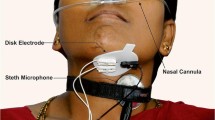Abstract
Purpose
Expiratory flow towards the upper airway after swallowing serves to expel liquid or food particles misdirected towards the trachea during swallowing. However, expiration may not occur consistently after swallowing in tracheostomised patients with an open tracheostomy tube. We investigated the effect of a speaking valve (SV) on breathing–swallowing interactions and on the volume expelled through the upper airway after swallowing.
Methods
Eight tracheostomised neuromuscular patients who were able to breathe spontaneously were studied with and without an SV. Breathing–swallowing interactions were investigated by chin electromyography, cervical piezoelectric sensor, and nasal and tracheal flow recording. Three water-bolus sizes (5, 10, and 15 mL) were tested in random order.
Results
Swallowing characteristics and breathing–swallowing synchronisation were not influenced by SV use. However, expiratory flow towards the upper airway after swallowing was negligible without the SV and was restored by adding the SV.
Conclusion
In tracheostomised patients, protective expiration towards the upper airway after swallowing is restored by the use of an SV.


Similar content being viewed by others
References
Bonanno PC (1971) Swallowing dysfunction after tracheostomy. Ann Surg 174:29–33
Feldman SA, Deal CW, Urquhart W (1966) Disturbance of swallowing after tracheostomy. Lancet 1:954–955
Buckwalter JA, Sasaki CT (1984) Effect of tracheotomy on laryngeal function. Otolaryngol Clin North Am 17:41–48
DeVita MA, Spierer-Rundback L (1990) Swallowing disorders in patients with prolonged orotracheal intubation or tracheostomy tubes. Crit Care Med 18:1328–1330
Betts RH (1965) Post-tracheostomy aspiration. N Engl J Med 273:155
Eibling DE, Gross RD (1996) Subglottic air pressure: a key component of swallowing efficiency. Ann Otol Rhinol Laryngol 105:253–258
Suiter DM, McCullough GH, Powell PW (2003) Effects of cuff deflation and one-way tracheostomy speaking valve placement on swallow physiology. Dysphagia 18:284–292
Gross RD, Mahlmann J, Grayhack JP (2003) Physiologic effects of open and closed tracheostomy tubes on the pharyngeal swallow. Ann Otol Rhinol Laryngol 112:143–152
Elpern EH, Borkgren Okonek M, Bacon M, Gerstung C, Skrzynski M (2000) Effect of the Passy-Muir tracheostomy speaking valve on pulmonary aspiration in adults. Heart Lung 29:287–293
Stachler RJ, Hamlet SL, Choi J, Fleming S (1996) Scintigraphic quantification of aspiration reduction with the Passy-Muir valve. Laryngoscope 106:231–234
Smith J, Wolkove N, Colacone A, Kreisman H (1989) Coordination of eating, drinking and breathing in adults. Chest 96:578–582
Martin BJ, Logemann JA, Shaker R, Dodds WJ (1994) Coordination between respiration and swallowing: respiratory phase relationships and temporal integration. J Appl Physiol 76:714–723
Nishino T, Yonezawa T, Honda Y (1985) Effects of swallowing on the pattern of continuous respiration in human adults. Am Rev Respir Dis 132:1219–1222
Paydarfar D, Gilbert RJ, Poppel CS, Nassab PF (1995) Respiratory phase resetting and airflow changes induced by swallowing in humans. J Physiol 483(Pt 1):273–288
Martin-Harris B, Brodsky MB, Price CC, Michel Y, Walters B (2003) Temporal coordination of pharyngeal and laryngeal dynamics with breathing during swallowing: single liquid swallows. J Appl Physiol 94:1735–1743
Boden K, Cedborg AI, Eriksson LI, Hedstrom HW, Kuylenstierna R, Sundman E, Ekberg O (2009) Swallowing and respiratory pattern in young healthy individuals recorded with high temporal resolution. Neurogastroenterol Motil 21:1163 e1101
Cohn MA, Rao AS, Broudy M, Birch S, Watson H, Atkins N, Davis B, Stott FD, Sackner MA (1982) The respiratory inductive plethysmograph: a new non-invasive monitor of respiration. Bull Eur Physiopathol Respir 18:643–658
Ertekin C, Pehlivan M, Aydogdu I, Ertas M, Uludag B, Celebi G, Colakoglu Z, Sagduyu A, Yuceyar N (1995) An electrophysiological investigation of deglutition in man. Muscle Nerve 18:1177–1186
Terzi N, Orlikowski D, Aegerter P, Lejaille M, Ruquet M, Zalcman G, Fermanian C, Raphael JC, Lofaso F (2007) Breathing–swallowing interaction in neuromuscular patients: a physiological evaluation. Am J Respir Crit Care Med 175:269–276
Hardemark Cedborg AI, Sundman E, Boden K, Hedstrom HW, Kuylenstierna R, Ekberg O, Eriksson LI (2009) Co-ordination of spontaneous swallowing with respiratory airflow and diaphragmatic and abdominal muscle activity in healthy adult humans. Exp Physiol 94:459–468
Martin-Harris B, Brodsky MB, Michel Y, Ford CL, Walters B, Heffner J (2005) Breathing and swallowing dynamics across the adult lifespan. Arch Otolaryngol Head Neck Surg 131:762–770
Ikari T, Sasaki CT (1980) Glottic closure reflex: control mechanisms. Ann Otol Rhinol Laryngol 89:220–224
Ertekin C, Aydogdu I, Yuceyar N, Kiylioglu N, Tarlaci S, Uludag B (2000) Pathophysiological mechanisms of oropharyngeal dysphagia in amyotrophic lateral sclerosis. Brain 123(Pt 1):125–140
Ertekin C, Yuceyar N, Aydogdu, Karasoy H (2001) Electrophysiological evaluation of oropharyngeal swallowing in myotonic dystrophy. J Neurol Neurosurg Psychiatry 70:363–371
Gross RD, Atwood CW Jr, Ross SB, Olszewski JW, Eichhorn KA (2009) The coordination of breathing and swallowing in chronic obstructive pulmonary disease. Am J Respir Crit Care Med 179:559–565
Nishino T, Hasegawa R, Ide T, Isono S (1998) Hypercapnia enhances the development of coughing during continuous infusion of water into the pharynx. Am J Respir Crit Care Med 157:815–821
Kijima M, Isono S, Nishino T (1999) Coordination of swallowing and phases of respiration during added respiratory loads in awake subjects. Am J Respir Crit Care Med 159:1898–1902
Pane M, Vasta I, Messina S, Sorleti D, Aloysius A, Sciarra F, Mangiola F, Kinali M, Ricci E, Mercuri E (2006) Feeding problems and weight gain in Duchenne muscular dystrophy. Eur J Paediatr Neurol 10:231–236
Hadjikoutis S, Pickersgill TP, Dawson K, Wiles CM (2000) Abnormal patterns of breathing during swallowing in neurological disorders. Brain 123(Pt 9):1863–1873
Terzi N, Prigent H, Lejaille M, Falaize L, Annane D, Orlikowski D, Lofaso F (2010) Impact of tracheostomy on swallowing performance in Duchenne muscular dystrophy. Neuromuscul Disord 20:493–498
Acknowledgments
The study was supported by the Association d’Entraide des Polios et Handicapés (ADEP).
Author information
Authors and Affiliations
Corresponding author
Rights and permissions
About this article
Cite this article
Prigent, H., Lejaille, M., Terzi, N. et al. Effect of a tracheostomy speaking valve on breathing–swallowing interaction. Intensive Care Med 38, 85–90 (2012). https://doi.org/10.1007/s00134-011-2417-8
Received:
Accepted:
Published:
Issue Date:
DOI: https://doi.org/10.1007/s00134-011-2417-8




